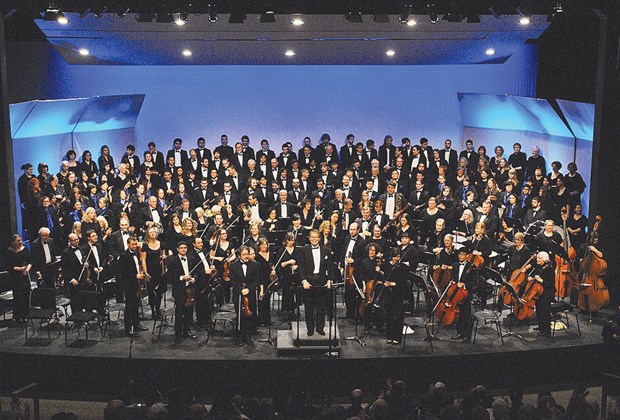Mozart's Requiem: Capilano University Festival Chorus and Capilano University Singers at BlueShore Financial Centre, Saturday, April 12, at 8 p.m. and Sunday, April 13 at 3 p.m.
Lars Kaario can almost get through an entire interview without singing - almost, but not quite.
While taking a brief break from holding 100 voices in his hands, the Capilano University choral director discusses the painstaking preparation warranted by Mozart's Requiem.
The choir is a blend of 50 community singers and 50 music students, all with the task of bringing life to the song of death.
Before tapping a music stand with a baton, Kaario has each note, pitch, vowel, and rhythm he wants from Mozart's 1791 tour de force in his mind.
"I have a distinct image, absolutely, and I work on it till we get that sound," he says.
Asked how he knows what he wants, Kaario explains the ever-present link between the sound of the music and craftsmanship of the instrument.
"Back in the baroque and early classical periods the instruments could not produce a really heavy sound," he says.
A modern Steinway piano is probably 10 times as loud as the pianoforte of Mozart's time, which almost sounded like a honky tonk piano, according to Kaario. The violin was similarly about one-third the volume of the instruments that would be crafted in the next century.
The nature of the instruments had a direct effect on the performance of the singers, Kaario says.
"We know for instance, that in the early period they didn't sing so heavy because they didn't have to, the instruments produced a very light sound."
For romantic opera, the singer's voice does not waver.
"PAH, PAH, PAH," Kaario sings.
If you could see his voice, it would look like Canada's prairies - one flat line.
Then Kaario sings an early baroque style.
"Pah, pah, pah." Each baroque note has its own topography, and if you could see it the notes might look like Ireland's rolling hills.
But while the development of musical instruments plays a part in the choir's performance, something more essential and more mysterious is also at work.
"Human nature," Kaario says. "There's a lot of things that you just naturally pick up by the way the music is written."
The music captivates musicians by holding wrath and befuddlement and the sublime, sometimes within the same movement.
"They just love the Requiem," he says of his community choir singers. "They find it so fulfilling."
Beyond what's written on the page, the Requiem has attained an almost mythical quality. Most listeners can separate Beethoven's Eroica from the rise of Napoleon Bonaparte, just as they can listen to Carly Simon's "You're So Vain" without thinking of Mick Jagger or Warren Beatty or whoever. But the Requiem is Mozart.
"There's a real sense of pathos which I think connects to Mozart dying," Kaario says.
A tall man in a grey suit knocks on the composer's door with an assignment. The man in grey is an emissary for a widower, a count, and a thief. The composer is Amadeus Mozart.
The assignment: a death mass. In the autumn of 1791 Count Franz von Walsegg waits for the Requiem. Walsegg lost his young wife on Feb. 14, 1791. But while he is beset by sorrow, he is also afflicted by an ego of Shia LeBeoufian proportions.
When Walsegg buys the Requiem it will become his property and bear his name. But while Mozart worked on the Requiem he was coming undone.
The doctors would diagnose him with rheumatic fever after his death, but in the final weeks of life Mozart suspected he'd been poisoned. He even wondered if the guilty party might be court composer Antonio Salieri.
That suspicion would lead to a more famous story in which Salieri tranquilizes the envy coursing through his soul by destroying God's crudest instrument - that giggling, drunken boy.
The legend seems false, but it's not without shadow versions of the truth. Constanze, Mozart's wife, took the Requiem from her husband when he confessed he was writing his own death mass.
By some accounts, Mozart was dictating the Requiem until moments before his death. Had it been completed and delivered to Walsegg, musical history may have been distorted, or even worse, the composition could have been bastardized or lost. As it turned out, Mozart was prophetic. His unfinished Requiem was played five days after his death at his own funeral.
Kaario was 15 when music took hold. "It just became my passion. . . . My parents weren't too happy," he adds with a laugh.
While his parents wanted their son to appreciate music, taking him to light opera as a child, his father hoped he would do something practical, like become an electrical engineer or a teacher.
"There was no way I was supposed to have a career in music," Kaario says. Kaario found himself teaching voice, conducting musical theatre, directing a church choir and performing as a tenor soloist in an effort to make ends meet.
"It is exciting but it can be a little bit stressful trying to make a comfortable living," he says. But like a Romantic opera singer, Kaario never wavered.
"If you really follow your passion and you're willing to spend the time to work hard, you'll find some work in the field that you love," he says.
His education in music seems like it would be beyond endurance, as he'd frequently spend 12-14 hours each day immersed in music, as well as in its theory and history.
Asked if he ever had concerns about burnout, Kaario seems taken aback. "Absolutely not," he says. "Oh my goodness no."
Asked about final instructions for the choir, Kaario says he'll remind them to enjoy the moment. "It goes by so quickly," he says. "In fact, the performance goes by like a little bit of a dream for the time of the performance and then it's over."



